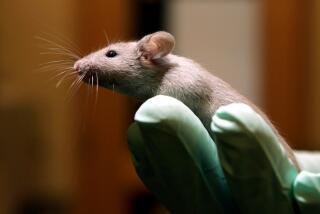Rat Clone Is New Big Cheese of the Lab
- Share via
After years of frustrating failures, scientists have succeeded in cloning the laboratory rat, Rattus norvegicus.
The feat -- news of which was published online Thursday in the journal Science -- was hailed as a boon to medical research because the rat is the animal of choice for studying such human diseases as hypertension, obesity, diabetes, addiction and heart disease.
It also adds new glitz to the rat as a research tool. In labs, the rat has long been eclipsed by its more glamorous cousin, the mouse, which has been a powerhouse for genetics research for decades and has been cloned since 1998.
“This opens the door for us -- it is critical for moving the rat further along in medical research,” said John Critser, chairman of veterinary pathobiology at the University of Missouri and director of the Rat Resource and Research Center.
The four new rat clones, two males and two females, have grown into fertile adults with no sign of abnormality or disease, said Alexandre Fraichard, chief executive of genOway, a French biotechnology company that produced them in collaboration with France’s National Institute for Agricultural Research.
Ralph, the oldest of the four, will be a year old on Nov. 30, Fraichard said.
Cloning is a technique to create genetically identical copies of animals. It involves removing the genetic material from an egg, then replacing it with DNA from a nonreproductive cell. The egg is induced to divide into an embryo, and is inserted into a surrogate mother to develop into a baby animal.
Starting with the birth of Dolly the sheep in 1996, a variety of animals has been cloned, including mice, pigs, cows, a cat, a horse and a mule.
But each species has reproductive foibles that must be overcome -- and the cloning of some species, such as dogs and monkeys, has so far proved impossible.
Rats were especially tough because their eggs start to develop as soon as they’re put in a dish -- before the technicians can perform their DNA-swapping task. As a result, embryos die while still tiny clusters of cells.
The French team overcame this barrier by adding a chemical inhibitor that temporarily blocked egg development, giving the technicians time to do their work.
“It was absolutely the right approach -- fabulous,” said Dr. Philip Iannaccone, professor of pediatrics at Northwestern University’s Feinberg School of Medicine in Chicago.
Iannaccone has been working on a similar inhibitor method. “We’ll be very quickly attempting to reproduce what they did,” he said.
The French scientists used fetal skin cells as a DNA source and conducted 876 procedures before producing Ralph and his three fellow clones (which have no names). Such low efficiency rates have been observed with every species thus far cloned, and are probably due to the fact that genes in skin and other nonreproductive cells are in a chemical state not tailor-made for growing an embryo.
Scientists have long wanted to clone rats because they could then perform many experiments that can now be done only on mice.
Cloning will allow scientists to alter rat genes with precision. For instance, they will be able to remove genes to better understand their functions, or replace rat genes with human ones to create better models for studying human ailments.
Rats are more suitable for certain experiments than mice. They are easier to handle -- in having blood drawn, for example.
Also, their physiology is better understood and more similar to humans with respect to certain medical conditions.






